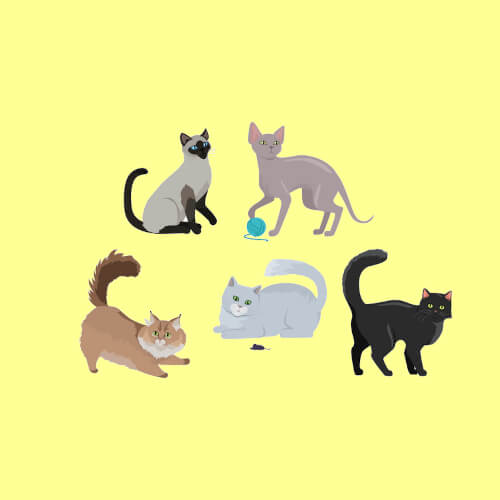


A cat (Felis catus), or domestic cat, is a species of small, carnivorous mammal. Cats are the only domesticated species of the taxonomic family Felidae, which also includes big cats such as lions, tigers, and panthers. Cats have strong, flexible bodies; fast reflexes; sharp, pointed teeth; retractable claws; and strong night vision. Cats are the second most popular pet in the world, behind dogs.
| Taxonomic Rank | Name | Common Name |
|---|---|---|
| Kingdom | Animalia | Animals |
| Phylum | Chordata | Vertebrates |
| Class | Mammalia | Mammals |
| Order | Carnivora | Carnivores |
| Family | Felidae | Cats |
| Genus | Felis | Small-medium cat species |
| Species | Felis catus | Domestic cat |
The International Cat Association (ICA), which is the world's largest registry of cat pedigrees, or cat breeding history, recognizes 73 different breeds. That being said, the Fédération Internationale Féline only recognizes 48 breeds and the largest American organization, the Cat Fanciers' Association (CFA), only recognizes 45 different breeds. Lastly, Encyclopedia Britannica claims that only around 30-40 breeds exist.
| Language | Sounds like... |
|---|---|
| English | Meow |
| Estonian | Näu |
| French | Miaou |
| German | Miau |
| Italian | Miao |
| Language | Sounds Like... |
|---|---|
| Japanese | Nyan |
| Korean | Yaong |
| Russian | Myau |
| Spanish | Miau |
| Swedish | Mjau |
Cats' sleeping patterns can be traced to their history as predators. As natural hunters, cats need to conserve their energy for brief but intense periods of activity, such as chasing and catching prey. They also have the ability to sleep lightly, so they can quickly wake up and be alert if necessary.
In addition to their sleep, grooming is also an essential part of a cat's daily routine. It not only helps them maintain a clean coat, but it also serves as a way for them to relax and destress. So, next time you see your feline friend taking a long nap or grooming themselves, you can appreciate that it's all part of their instinctual behavior—even if they seem a little lazy!
While the average adult domestic cat typically has a mass of about 4.5 kg (9.9 lbs), there have been some truly massive felines recorded in history. In fact, the Guinness World Record for the heaviest cat ever recorded goes to a ginger tabby named Himmy from Queensland, Australia. Himmy weighed a staggering 21.3 kg (47.0 lbs), which is about five times the mass of an average domestic cat.
Unfortunately, Himmy's size contributed to health problems, and he passed away at the age of 10 due to respiratory failure. While it can be tempting to overfeed our furry friends, it's essential to keep them at a healthy weight to ensure they live long and happy lives.
While our domestic feline friends are known for their cute sounds, it may come as a surprise that wild and feral cats don't meow. Meowing is a noise that house cats have developed specifically to communicate with humans. In the wild, cats rely on body language, scent marking, and other sounds such as growls and hisses to communicate with one another. However, over thousands of years of living with people, cats have learned that meowing is an effective way to get the attention of their human companions. So the next time your furry friend meows at you, remember that they've learned this skill just to communicate with you... or get you to feed them!
Cats are known for their acute sense of hearing, and their ears are designed to help them locate prey and sense danger. One fascinating fact about cat ears is that they can rotate almost 180 degrees, which means they can point their ears both forward and backward. This impressive range of motion allows cats to pick up sounds from many different directions without having to move their heads. Additionally, the ear muscles in cats are highly developed and allow for quick adjustments in ear position to help them pinpoint the location of a sound.
While many animals, including humans, have a sweet tooth, cats are not able to taste sweet foods due to a defect in the gene responsible for the sweet taste receptor. This means that cats are unable to taste sugar or other sweet substances, and as a result, they don't crave sugary treats the way humans do. Instead, cats have a highly developed sense of taste for protein and fat, which are essential for their survival. This is why many commercial cat foods are formulated to be high in protein and fat, as these are the flavors that cats enjoy the most.
Archaeologists estimate that the first African wildcats were tamed about 9,500 years ago based on evidence found in graves on Cyprus, an island country in the eastern Mediterranean Sea near Turkey. Even though we often associate cats with ancient Egyptians, it's likely that the Egyptians didn't keep cats until about 2,000 years later.